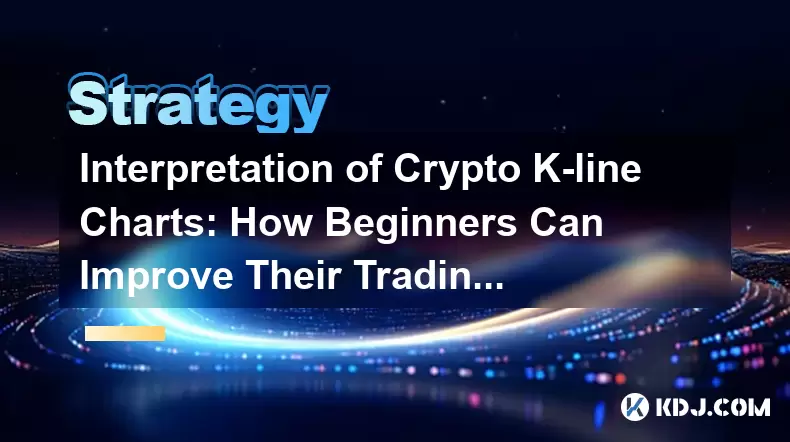-
 bitcoin
bitcoin $120167.907534 USD
1.27% -
 ethereum
ethereum $4468.611945 USD
2.53% -
 xrp
xrp $3.013607 USD
1.80% -
 tether
tether $1.000549 USD
-0.01% -
 bnb
bnb $1092.592149 USD
6.28% -
 solana
solana $231.391244 USD
4.59% -
 usd-coin
usd-coin $0.999699 USD
-0.04% -
 dogecoin
dogecoin $0.259020 USD
4.30% -
 tron
tron $0.342747 USD
0.34% -
 cardano
cardano $0.860977 USD
1.07% -
 hyperliquid
hyperliquid $50.155412 USD
5.34% -
 chainlink
chainlink $22.637678 USD
0.46% -
 ethena-usde
ethena-usde $1.000528 USD
-0.07% -
 avalanche
avalanche $30.613779 USD
-0.07% -
 stellar
stellar $0.403905 USD
0.94%
Interpretation of Crypto K-line Charts: How Beginners Can Improve Their Trading Winning Rates through Chart Analysis
K-line charts reveal price trends and reversals through candlestick patterns, helping traders spot entry points and market sentiment shifts.
Jun 12, 2025 at 05:00 am

Understanding the Basics of K-line Charts
K-line charts, also known as candlestick charts, are essential tools in cryptocurrency trading. They originated from Japanese rice traders and have since become a staple in financial markets, including crypto. Each candlestick represents price movement over a specific time frame, showing open, high, low, and close prices.
The body of the candle reflects the range between the opening and closing prices. If the close is higher than the open, it's typically displayed as a green or hollow candle; if lower, it appears red or filled. The wicks or shadows indicate the highest and lowest prices reached during that period.
For beginners, understanding how to read these elements helps identify potential market sentiment shifts. For instance, a long upper wick may suggest rejection at higher prices, while a long lower wick could signal strong buying pressure.
Recognizing Common Candlestick Patterns
Certain candlestick patterns provide insights into possible future price movements. Recognizing these can significantly improve a trader’s ability to make informed decisions.
- Bullish Engulfing Pattern: This occurs when a small bearish candle is followed by a larger bullish candle that completely engulfs the previous one. It suggests a potential reversal from a downtrend.
- Bearish Engulfing Pattern: Conversely, this pattern appears after an uptrend and indicates a likely reversal to a downtrend.
- Hammer and Inverted Hammer: These candlesticks usually appear at the bottom of a downtrend. A hammer has a long lower shadow and signals potential bullish reversal.
- Shooting Star and Hanging Man: These resemble inverted hammers but appear at the top of an uptrend, suggesting bearish momentum might take over.
Each pattern must be interpreted within the context of the current trend and volume levels to increase accuracy in predictions.
Using Support and Resistance Levels with K-lines
Identifying support and resistance levels enhances K-line analysis. Support is a price level where demand is strong enough to prevent further decline, while resistance is where selling pressure halts upward movement.
Traders often draw horizontal lines connecting past lows (support) or highs (resistance). When a candlestick touches or bounces off these levels, it provides confirmation of their significance.
Combining these levels with candlestick behavior increases reliability. For example, a bullish engulfing pattern forming near a strong support zone can serve as a compelling entry point for buyers.
Additionally, watching for breakouts—when price moves beyond established support or resistance—is crucial. Confirming such moves through candlestick formations like piercing lines or dark cloud covers can help avoid false breakouts.
Incorporating Volume Analysis into K-line Interpretation
Volume plays a critical role in validating candlestick patterns. High trading volume during a particular candle adds weight to its implications.
A spinning top with low volume may suggest indecision, while a marubozu candle with high volume confirms strong buying or selling pressure depending on its direction.
Analyzing volume divergence can also highlight potential reversals. For instance, if price makes a new high but volume remains low compared to previous peaks, it may signal weakening momentum.
Beginners should use volume indicators like OBV (On-Balance Volume) or simply observe the volume bars beneath K-line charts to assess whether trends are supported by actual market participation.
Practical Tips for Beginners Using K-line Charts
To start applying K-line chart analysis effectively, beginners should follow a structured approach:
- Start with Higher Timeframes: Use daily or 4-hour charts initially to grasp broader trends before diving into shorter intervals.
- Focus on a Few Patterns First: Master key candlestick formations like doji, engulfing patterns, and hammers before expanding your knowledge.
- Use Multiple Timeframe Analysis: Confirm signals on different timeframes to reduce false positives. For instance, check if a bullish signal on the 1-hour chart aligns with a larger trend on the daily chart.
- Combine with Other Indicators: Overlay moving averages or RSI to filter out noise and strengthen trade setups.
- Practice on Demo Accounts: Before risking real money, test strategies using paper trading platforms or demo accounts offered by many exchanges.
Maintaining a trading journal to record each decision based on K-line signals helps track progress and refine strategies over time.
Frequently Asked Questions
Q: Can I rely solely on K-line charts for trading decisions?While K-line charts offer valuable insights, combining them with other analytical tools like volume indicators, moving averages, or fundamental data improves decision-making accuracy.
Q: How do I know if a candlestick pattern is reliable?Pattern reliability increases when confirmed by volume spikes, alignment with support/resistance levels, and consistency across multiple timeframes.
Q: What timeframe is best for K-line analysis as a beginner?Beginners should start with daily or 4-hour charts to understand overall trends without being overwhelmed by short-term volatility.
Q: Should I always wait for a candle to close before making a trade?Yes, waiting for the candle to close prevents acting on false signals. Premature entries based on incomplete candles can lead to inaccurate readings and losses.
Disclaimer:info@kdj.com
The information provided is not trading advice. kdj.com does not assume any responsibility for any investments made based on the information provided in this article. Cryptocurrencies are highly volatile and it is highly recommended that you invest with caution after thorough research!
If you believe that the content used on this website infringes your copyright, please contact us immediately (info@kdj.com) and we will delete it promptly.
- BlockDAG, DOGE, HYPE Sponsorship: Crypto Trends Shaping 2025
- 2025-10-01 00:25:13
- Deutsche Börse and Circle: A StableCoin Adoption Powerhouse in Europe
- 2025-10-01 00:25:13
- BlockDAG's Presale Buzz: Is It the Crypto to Watch in October 2025?
- 2025-10-01 00:30:13
- Bitcoin, Crypto, and IQ: When Genius Meets Digital Gold?
- 2025-10-01 00:30:13
- Stablecoins, American Innovation, and Wallet Tokens: The Next Frontier
- 2025-10-01 00:35:12
- NBU, Coins, and Crypto in Ukraine: A New Yorker's Take
- 2025-10-01 00:45:14
Related knowledge

Practical parameter settings for a Bitcoin multi-timeframe moving average system
Sep 18,2025 at 10:54pm
Optimizing Timeframe Combinations for Bitcoin Trading1. Selecting appropriate timeframes is crucial when building a multi-timeframe moving average sys...

How can I filter out false breakouts in Dogecoin high-frequency trading?
Sep 22,2025 at 01:00am
Understanding False Breakouts in Dogecoin Trading1. A false breakout occurs when Dogecoin's price appears to move beyond a defined support or resistan...

Techniques for identifying tops and bottoms in the Bitcoin on-chain NVT model
Sep 20,2025 at 07:54pm
Understanding the NVT Model in Bitcoin Analysis1. The Network Value to Transactions (NVT) ratio is often described as the 'P/E ratio' of the cryptocur...

What does the surge in open interest in Bitcoincoin futures mean?
Sep 20,2025 at 11:18pm
Understanding the Surge in Dogecoin Futures Open Interest1. A surge in open interest within Dogecoin futures indicates a growing number of active cont...

How can I use the Ethereum USDT premium to gauge market sentiment?
Sep 18,2025 at 11:55pm
Understanding the Ethereum USDT Premium1. The Ethereum USDT premium refers to the price difference between USDT (Tether) traded on Ethereum-based plat...

What should I do if Ethereum staking yields decline?
Sep 20,2025 at 06:18am
Understanding the Causes Behind Declining Ethereum Staking Yields1. The Ethereum network transitioned to a proof-of-stake consensus mechanism with the...

Practical parameter settings for a Bitcoin multi-timeframe moving average system
Sep 18,2025 at 10:54pm
Optimizing Timeframe Combinations for Bitcoin Trading1. Selecting appropriate timeframes is crucial when building a multi-timeframe moving average sys...

How can I filter out false breakouts in Dogecoin high-frequency trading?
Sep 22,2025 at 01:00am
Understanding False Breakouts in Dogecoin Trading1. A false breakout occurs when Dogecoin's price appears to move beyond a defined support or resistan...

Techniques for identifying tops and bottoms in the Bitcoin on-chain NVT model
Sep 20,2025 at 07:54pm
Understanding the NVT Model in Bitcoin Analysis1. The Network Value to Transactions (NVT) ratio is often described as the 'P/E ratio' of the cryptocur...

What does the surge in open interest in Bitcoincoin futures mean?
Sep 20,2025 at 11:18pm
Understanding the Surge in Dogecoin Futures Open Interest1. A surge in open interest within Dogecoin futures indicates a growing number of active cont...

How can I use the Ethereum USDT premium to gauge market sentiment?
Sep 18,2025 at 11:55pm
Understanding the Ethereum USDT Premium1. The Ethereum USDT premium refers to the price difference between USDT (Tether) traded on Ethereum-based plat...

What should I do if Ethereum staking yields decline?
Sep 20,2025 at 06:18am
Understanding the Causes Behind Declining Ethereum Staking Yields1. The Ethereum network transitioned to a proof-of-stake consensus mechanism with the...
See all articles










































































